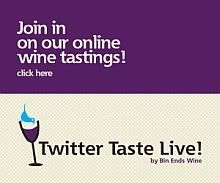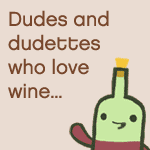 Hey, U.S. peeps - you folks who are still on the inaugural high - have you ever scoffed with national pride at the wine labels from other countries?
Hey, U.S. peeps - you folks who are still on the inaugural high - have you ever scoffed with national pride at the wine labels from other countries?
"Ha," you might scoff to yourself when perusing the aisles at your favorite wine shop, "I'm glad that wine labels from my country don't have anything to hide, and aren't hard to read. Like those crazy German wine labels that the 1WineDude talked about. I scoff at those!"
Hang on there, scoffer, and pay attention, lest you become a suckah. Just because U.S. wine labels don't use foreign words with 27 consonants in them doesn't mean that they are simple. Not to worry, though - Dude here is gonna hook up UP!
First, we should talk about the stuff that has to (by law) appear on a wine label if that wine is sold in the U.S.:
- Brand: Usually the same as the producer, but not always. It's almost always prominent text in big font on the label, and the brand is almost always an intellectual property of the producer.
- Varietal or Type: The label needs to state if you're making fruit wine, for example, or mead. For grape wine, you can use the grape varietal name: the wine needs to be made from at least 75% of the stated varietal (except in OR, where it's 90%).. Some generic names are still legally permitted, such as "sake" and "vermouth."
- Bottler & Importer: Name & address of who bottled the wine, and int he case of imported wines who imported it.
- Alcohol: This is ALWAYS on the label. Yes, it is. Sometimes the font is just so small that you can't read, but it IS there. I promise.
- Sulfite & Health warnings: Required by law (for sulfites, this is if the wine exceeds 10 ppm, which is about 99.99999% of the wines in the world) but are almost entirely useless. Don't get me started on the whole sulfite thing.
- Net Contents: Usually stated in ml. As in 750 ml (the volume of a standard wine bottle).
The following are usually not required but you frequently see them on quality wines:
- Appelation: Where the grapes originated. For most geogrpahic descriptions on a wine label, 75% of the grapes used in the wine must have come from there. The more specific the geography, the higher the minimum percentage: 85% for AVAs, for example.
- Vintage: The year the grapes were harvested. 95% of the wine must have been harvested & crushed that year (though I've no idea how you'd prove that...).
- Vineyard name: If used, 95% of the grapes must have been grown there.
But wait... it gets even trickier!
 The more perceptive among you might have noticed that the back label of wine bottles usually have a statement by the name of the producer such as "Produced By" or "Cellared By". There is a reason why they are different: they have legal definitions:
The more perceptive among you might have noticed that the back label of wine bottles usually have a statement by the name of the producer such as "Produced By" or "Cellared By". There is a reason why they are different: they have legal definitions:- Cellared By, Selected By or Vinted By: The producer crushed less than 10% of the grapes.
- Made By: They crushed 10% of the grapes.
- Produced By: They crushed 75% of the grapes.
- Grown, Produced and Bottled By: 100% of the grapes come from land owned or controlled by the winery and the winery crushed, fermented, aged & bottled the wine in a "continuous process."
- Estate Bottled: Pretty much the same as "Grown, Produced and Bottled By" but the winery is located in an AVA (the same one where the grapes were located).
Not so simple, eh Mr. & Mrs. Scoffer?
And finally, the following terms look impressive on a label, but have no legal meaning whatsoever:
- Reserve
- Special Selection
- Old Vines
Cheers!
(images: 1WineDude.com)



























9 comments:
Wow, 'Made by' and 'Produced by' not legally the same thing? You learn something new every day, that's for sure!
Thanks, Spud! I often find myself advising folks browsing at the wine shop who are ooh-ing and ahh-ing over a "Reserve" wine.
"Uhm... be careful there..." :-)
Thanks! Who knew?
My personal pet peeve is the 'organic wine' label versus the 'made from organically grown grapes'.
But you are right...don't get me started on the sulfite thing!
Thanks, jdv!
Amy - I hear you... I have a personal love/hate affair with organic wine... and the sulfite thing is basically the dumbest warning *ever*. In my opinion, anyway. And it's all about opinions these days, right? ;-)
First visit to your site. Great info. I loved how back in the day many Cali Cabernet vintners would slap an additional private reserve label on the shoulder of their bottles that hadn't sold yet and then raise the price five or more dollars to cover the cost of opening up all the cases and running them through the bottling line again. Convoluted production and labeling rules may have been designed to protect and inform the consumer but the truth is the opportunity to skirt the rules if one chooses abound. The informed wino will always pick up the bottle and read the front and back label. It's part of the game. I'm sure you agree it's what's inside the bottle that counts. Trust your palate. Definitely returning to check out more of your thoughts.
Wine on
Thanks, AJ!
Great Topic! More needs to be written about this.
Basically the law says mandatory info MUST be legible on the label.
For the Mandatory requirements, they also set a minimum type size. 2mm is the minimum for bottles over 187ml in size, and 1mm for bottles 187ml and smaller (alc statement is excluded from this because it has it's own min).
They give an absolute minimum type size of 1mm for the Alc statement (and a max of 3mm) Don't want you flaunting your Alc % in huge type!
Also, the alc % doesn't HAVE to be on the label (unless you are over 14.1%). If you are under 14.1% you may 'chose' to say "Table Wine" and not show the alc %.
Those labels where you can't find the alc% probably say 'Table Wine' or 'Light Wine'!
Thanks, Tracy - great clarification!
Post a Comment